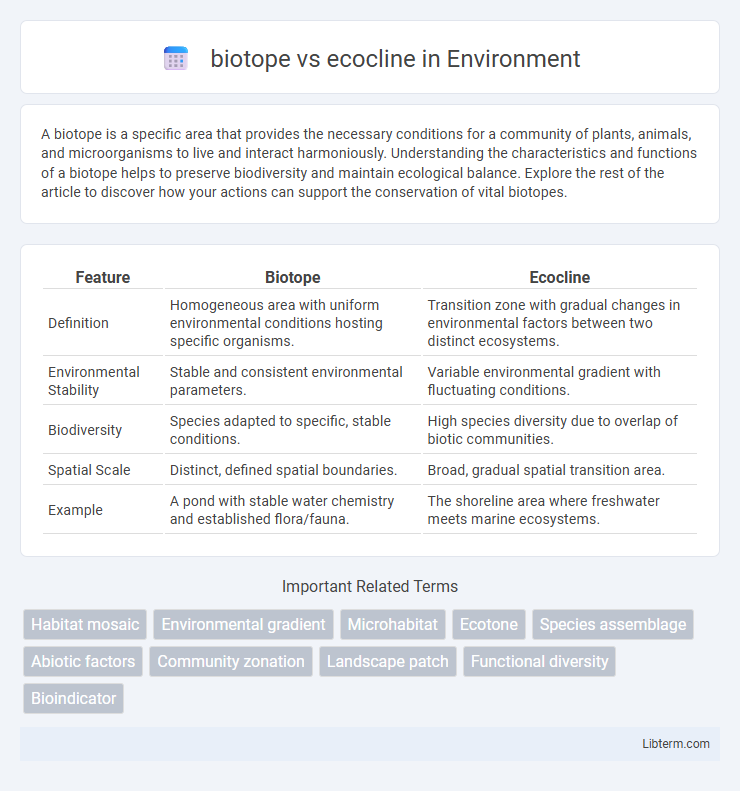A biotope is a specific area that provides the necessary conditions for a community of plants, animals, and microorganisms to live and interact harmoniously. Understanding the characteristics and functions of a biotope helps to preserve biodiversity and maintain ecological balance. Explore the rest of the article to discover how your actions can support the conservation of vital biotopes.
Table of Comparison
| Feature | Biotope | Ecocline |
|---|---|---|
| Definition | Homogeneous area with uniform environmental conditions hosting specific organisms. | Transition zone with gradual changes in environmental factors between two distinct ecosystems. |
| Environmental Stability | Stable and consistent environmental parameters. | Variable environmental gradient with fluctuating conditions. |
| Biodiversity | Species adapted to specific, stable conditions. | High species diversity due to overlap of biotic communities. |
| Spatial Scale | Distinct, defined spatial boundaries. | Broad, gradual spatial transition area. |
| Example | A pond with stable water chemistry and established flora/fauna. | The shoreline area where freshwater meets marine ecosystems. |
Introduction to Biotope and Ecocline
A biotope is a specific geographic area characterized by uniform environmental conditions and distinct flora and fauna, forming a stable habitat for particular species. An ecocline represents a gradual transition zone where environmental gradients cause a continuous change in species composition between adjacent biotopes. Understanding biotopes and ecoclines is fundamental in ecology for analyzing habitat distribution, biodiversity, and ecosystem dynamics.
Defining Biotope: Key Characteristics
A biotope refers to a specific geographic area with uniform environmental conditions, supporting a community of plants, animals, and microorganisms adapted to that habitat. It features consistent abiotic factors like soil type, moisture, temperature, and light that create a stable environment for resident species. Unlike an ecocline, which represents a gradual transition between distinct ecosystems, a biotope is characterized by its homogeneous nature and clearly defined ecological boundaries.
Understanding Ecocline: Core Concepts
Ecocline represents a gradual transition zone between two distinct ecosystems, characterized by a continuous change in environmental conditions and species composition. This gradient differs from a biotope, which is a relatively uniform habitat with consistent abiotic factors and biological communities. Understanding ecoclines involves analyzing species adaptations and interactions across varying microhabitats influenced by factors such as moisture, temperature, and soil composition.
Differences Between Biotope and Ecocline
A biotope is a geographically uniform area with specific environmental conditions and a distinct community of flora and fauna, serving as a stable habitat. In contrast, an ecocline represents a gradient or transitional zone where environmental conditions change gradually, leading to a continuous variation in species composition. The primary difference lies in biotope's spatial homogeneity versus ecocline's ecological gradient across habitats.
Ecological Significance of Biotopes
Biotopes represent distinct physical environments with uniform conditions that support specific communities of plants and animals, making them crucial for biodiversity conservation and ecosystem stability. Their ecological significance lies in providing habitat continuity, facilitating species interactions, and preserving local genetic resources. Compared to ecoclines, which are transitional zones exhibiting gradual changes in environmental conditions, biotopes maintain more stable and well-defined habitats essential for sustaining specialized species and ecological functions.
Importance of Ecoclines in Biodiversity
Ecoclines represent gradual environmental gradients where species composition shifts, creating unique habitats that support high biodiversity through ecological niches. These transitional zones enable species adaptation and migration, enhancing genetic diversity and ecosystem resilience. Unlike biotopes, which are relatively homogeneous habitats, ecoclines drive dynamic biological interactions essential for sustaining complex ecosystems.
Real-World Examples of Biotopes
Biotopes are specific habitats characterized by uniform environmental conditions, such as a freshwater pond or a desert oasis, supporting distinct communities of plants and animals. In contrast, ecoclines represent gradual transitions between biotopes, where species composition and environmental factors change progressively, like the shift from coastal marshland to upland forest. Real-world examples of biotopes include the coral reefs of the Great Barrier Reef, alpine tundra in the Rocky Mountains, and mangrove swamps along the Florida coastline, each hosting unique biodiversity adapted to those precise environmental settings.
Real-World Examples of Ecoclines
Ecoclines represent gradual environmental gradients where species composition shifts continuously, such as the transition zones between alpine forests and subalpine meadows in the Rocky Mountains or the mangrove-to-seagrass ecocline along coastal Florida. Unlike biotopes, which are uniform habitats supporting a specific set of organisms, ecoclines showcase dynamic species assemblages responding to changing abiotic factors like soil moisture and salinity. Real-world ecoclines highlight biodiversity hotspots, exemplified by the salt marsh-to-terrestrial ecocline supporting diverse bird and plant species in the Wadden Sea region of Northern Europe.
Biotope vs. Ecocline: Applications in Conservation
Biotope refers to a homogeneous environment supporting specific communities of flora and fauna, crucial for targeted conservation efforts by preserving habitat integrity and biodiversity. Ecocline represents a gradient of environmental conditions where species composition gradually shifts, offering insights into ecosystem transitions and adaptive management practices in conservation planning. Understanding the distinction between biotopes and ecoclines enhances habitat restoration, species protection, and ecological network connectivity strategies.
Conclusion: Integrating Biotope and Ecocline Concepts
Integrating biotope and ecocline concepts enhances ecosystem understanding by combining habitat-specific characteristics with gradual environmental gradients. This synthesis supports more accurate biodiversity assessments and adaptive management strategies in ecology. Recognizing both discrete habitats and transitional zones allows for effective conservation planning and sustainable ecosystem services.
biotope Infographic

 libterm.com
libterm.com